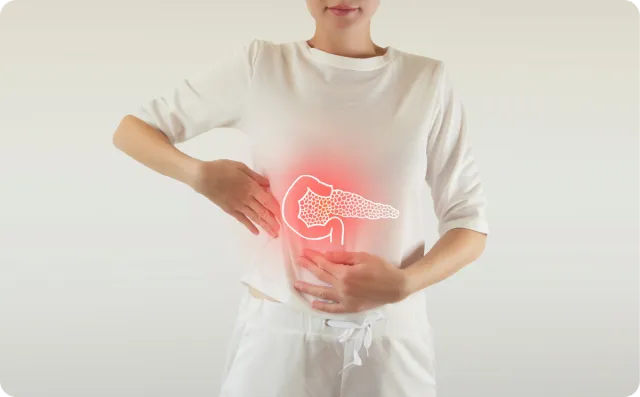
Jump to
Book a visit
$25 typical copay
$150 without insurance
Get fast relief for vomiting with a virtual GI consultation.
A virtual GI consultation allows you to discuss vomiting symptoms, including unusual colors and blood, with an expert who can provide insights and treatment options.
Key takeaways:
- Green vomit often indicates that bile is present in the stomach; this can happen if you vomit when your stomach is empty.
- In some cases, green vomit may be a sign of a more serious condition, such as a blockage in your intestines or other digestive disorders.
- Recognizing when you should reach out for medical help is important for proper diagnosis and treatment.
- Consulting a healthcare provider is essential if green vomit occurs often, is accompanied by severe pain, or occurs along with other symptoms like diarrhea, dehydration, or fever.
Throwing up is never a pleasant experience – but noticing that the vomit is green can be especially unsettling. So, it’s natural to wonder if you should be concerned. Green-colored vomit almost always contains the digestive fluid known as bile. The reason for green-colored vomit could be simply that your stomach is empty. But it could also mean a more serious digestive problem.
This article will discuss what green vomit means, its causes, and when it might indicate a serious problem, as well as how it’s treated.
What is green-colored vomit or bile?
Green vomit is an indication that bile is present where it isn’t supposed to be – in your stomach. Bile is a yellowish-green digestive fluid that’s produced by the liver and stored in the gallbladder. Whenever you eat foods that contain fat, the gallbladder releases bile into the small intestine. There, bile plays an important part in the digestive system by helping the body break down fats into fatty acids.
Quite often, vomiting bile is due to having an empty stomach. But bringing up green-colored vomit can also indicate a digestive problem.
When throwing up green vomit or bile may be serious
Sometimes, green vomit results from a serious medical problem, like a blockage in the small intestine. This blockage can keep food and liquids from moving through your digestive system, causing bile to back up into your stomach.
If you have an intestinal blockage, you will likely have other symptoms such as severe abdominal pain or vomiting that won’t stop. If you have these symptoms, it’s important to get medical care immediately.
Common causes of green vomit or bile
Green vomit or bile can result from several different conditions, and each has its own symptoms.
Biliary reflux
Biliary reflux (sometimes called bile reflux) occurs when bile flows back (refluxes) into your stomach, leading to irritation. Much of the bile produced by the liver is stored in the gallbladder.
As mentioned earlier, when you eat, bile is released from the gallbladder into your small intestine to help you digest fats. Sometimes bile can wash back into the stomach or even into the esophagus. This usually occurs when one of the valves, whose job is to prevent backwash, isn’t working properly. When that happens, it can cause green-colored vomit. It may also cause symptoms like upper abdominal pain, nausea, and a bitter taste in your mouth.
Gastroenteritis
Gastroenteritis, often called the stomach flu, is a common cause of nausea and vomiting. It’s not actually the flu, which is a respiratory illness caused by the influenza virus. Stomach flu is caused by a different type of virus, such as norovirus. Another cause is food poisoning from food that’s contaminated with salmonella or other bacteria. When your stomach is empty (as it’s likely to be if you have an upset stomach), your vomit may contain greenish-colored bile.
Other symptoms of gastroenteritis include diarrhea, intestinal cramping, and sometimes fever. Most cases get better on their own with rest and fluids. It is important not to become dehydrated, so take frequent small sips of water, flat ginger ale, or sports drinks. If you continue to vomit or other symptoms become severe, you need to get medical assistance.
Bowel obstruction
A bowel obstruction in the small intestine prevents food and liquids from passing through. The two most common causes are scar tissue from prior surgery or the presence of a hernia. This sort of obstruction can cause bile to back up into your stomach, leading to green bile in vomit.
A bowel obstruction is a serious medical problem that can cause bloating and severe pain. It can also make you unable to move your bowels or pass gas. If you experience these symptoms, consult a healthcare provider immediately.
Common causes of green vomit or bile based on appearance
The appearance of green vomit can provide clues to its cause.
Dark green vomit or bile
A dark green color usually means vomit contains a high concentration of bile. This might occur when your stomach is empty or when your digestive tract is slow to process food.
If you’ve been vomiting, its color is dark green, and you’re feeling pain, be sure to seek medical attention. The same is true of dark green vomit that has continued for an extended period of time.
Bright green vomit or bile
Vomit can be bright green after you’ve consumed certain foods or beverages with artificial coloring – but it can also indicate the presence of bile in vomit.
If you start vomiting and see that it’s a bright green color without any known dietary cause, you should discuss it with your healthcare provider.
Green liquid vomit or bile
Liquid green vomit usually means there is little to no solid food in the stomach, which can lead to throwing up bile as liquid green vomit. This can happen if you have a stomach virus or after prolonged vomiting.
Be sure to get enough fluid intake to prevent dehydration. If you find that you can’t keep anything down for 12 hours or more, see your healthcare provider
Green vomit after drinking alcohol
Alcohol is a well-known irritant to the stomach lining. Drinking alcohol on an empty stomach can lead to vomiting green bile. If the vomiting won’t stop or you have other symptoms such as abdominal pain, get medical advice as soon as possible.
Vomiting green while pregnant
Although it’s called “morning sickness,” nausea and vomiting in pregnancy can happen any time of day. Morning sickness is common during pregnancy, with hormonal changes being the most common cause.
You can also vomit green bile when your stomach is empty. This type of nausea and vomiting is not usually serious – but if you’re pregnant and can’t stop vomiting, or if your nausea is unusually severe, you should see your physician.
Read our guides on different types of vomit and its colors for more.
Diagnosing the causes of green vomit or bile
The doctor will review your symptoms and medical history to diagnose the cause(s) of green vomit. In many cases, tests will be ordered, including:
- Physical examination: Your doctor may check for signs of dehydration by taking your vital signs and looking at the condition of your skin and the mucus membranes in your mouth. The doctor will also feel your abdomen for tenderness and signs of bloating.
- Blood tests: These tests can help identify an infection or problems with your liver function. They can also help assess the severity of dehydration. If your vomiting has gone on for an extended period of time, seek medical consultation.
- Imaging Tests: An ultrasound or CT scan can help detect blockages or other abnormalities in your digestive tract.
- Endoscopy: This procedure involves using a flexible tube to pass a small camera through your mouth and down the digestive tract. The test allows your healthcare provider to examine your esophagus, stomach, and upper intestine for signs of inflammation or obstruction.
Common treatment options for green vomit or bile
The treatment that works best for you depends on the cause of green vomit. Here are some common treatment options.
Hydration
Staying hydrated is very important, especially if vomiting is frequent and you can’t keep any foods or liquids down.
Dehydration can make nausea worse, and increased vomiting leads to worsening dehydration – which results in a vicious cycle. Oral rehydration beverages such as sports drinks (Pedialyte) may work. In the most severe cases, intravenous fluids may be necessary.
Medications
Anti-nausea drugs can help control nausea and vomiting. If you’re unable to keep oral medications down, they may be given as a suppository or in an injection. If you are experiencing bile reflux, your doctor may recommend medications that reduce acid production or improve the flow of bile.
Dietary changes
Be sure to avoid any foods that will irritate your stomach, such as spicy or very acidic foods.
Many times, eating smaller, more frequent meals (rather than attempting to eat two or three large meals a day) can help reduce symptoms. It’s also helpful to avoid high-fat foods since the more fat you eat, the more bile your liver produces.
Nasogastric tube
If you have a bowel obstruction that’s causing an intestinal blockage, a doctor may recommend the insertion of a nasogastric tube.
During this procedure, a thin tube is inserted through your nose and into your stomach to help decompress the stomach and intestines. In the process, it can help relieve pain and stop your vomiting. If the blockage is severe and other treatments don’t help, surgery may be necessary. This can remove the blockage and clear away any surrounding tissue that is damaged or dead.
Questions to ask your doctor about green vomit or bile
If you are vomiting and it’s a green color, here are some questions you can ask your healthcare provider:
- What could be causing this green vomit?
- Are there specific tests I need to confirm the diagnosis?
- What treatment options are best for me?
- How soon should I get follow-up care if my symptoms don’t get better?
Frequently asked questions: Green vomit or bile
What can you eat or drink after throwing up green vomit or bile?
After vomiting, you should start with small amounts of clear fluids like water, flat soda, or an oral rehydration solution like a sports drink or Pedialyte. Then, gradually introduce bland foods: saltine crackers, plain toast, flavored gelatin, or bananas. As your stomach tolerates, gradually add more foods.
Read our guide on what to eat or drink after vomiting for more.
Is green vomit or bile a sign of acid reflux?
Bile reflux and acid reflux are different conditions and can sometimes be hard for medical professionals to tell apart.
Although they aren’t the same, they can occur together. Both involve the reflux of stomach contents into your esophagus. Severe cases of acid reflux, especially when there is also bile reflux, can lead to green vomit.
Managing green vomit or bile
Green vomit or bile doesn’t always indicate a serious issue. But because it may be due to underlying conditions that are serious, it’s important to know when to contact your healthcare provider. By understanding possible causes, diagnostic tests, and treatment options, you can help manage your symptoms and avoid potentially serious complications.
General Medicine follows a strict editorial process, including using real experts to write our articles, vetted primary sources, fact-checking, a secondary medical review, and updates as necessary. This article was medically reviewed and fact checked by Dr. Lane Thaut, DO.
Sources
American College of Gastroenterology, “GERD: Gastroesophageal Reflux Disease,” American College of Gastroenterology, 2022. https://webfiles.gi.org/docs/patients/GERD-infographic-final_2022.pdf. Accessed October 10, 2024.
American College of Obstetricians and Gynecologists, “Morning Sickness: Nausea and Vomiting of Pregnancy,” ACOG website. www.acog.org/womens-health/faqs/morning-sickness-nausea-and-vomiting-of-pregnancy. Accessed October 10, 2024.
Centers for Disease Control and Prevention, “Signs and Symptoms,” Centers for Disease Control and Prevention website, U.S. Department of Health and Human Services. www.cdc.gov/food-safety/signs-symptoms/index.html. Accessed October 10, 2024.
Centers for Disease Control and Prevention. “About Norovirus,” Centers for Disease Control and Prevention website, U.S. Department of Health and Human Services. www.cdc.gov/norovirus/about/index.html. Accessed October 10, 2024.
“Intestinal Obstruction: Evaluation and Management.” American Family Physician, vol. 98, no. 6, 2018, pp. 362–370. www.aafp.org/pubs/afp/issues/2018/0915/p362.html. Accessed October 10, 2024.
McCabe, Marshall E., et al. “New Causes for the Old Problem of Bile Reflux Gastritis,” Clinical Gastroenterology and Hepatology, vol. 16, no. 9, 2018, pp. 1389–1392. www.cghjournal.org/article/S1542-3565(18)30222-2/pdf. Accessed October 10, 2024.
Our editorial standards
At General Medicine, we cut through the clutter to make health care clearer, faster, and easier to navigate. Every article is grounded in evidence-based research and peer-reviewed journals, reviewed by medical professionals, and written in accessible language that helps you make health decisions with confidence. We’re committed to ensuring the quality and trustworthiness of our content and editorial process by providing information that is up-to-date, accurate, and actually useful. For more details on our editorial process, see here.



